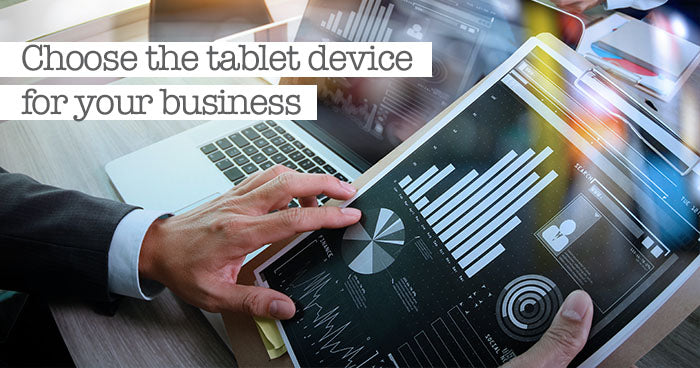Guide to Buying Tablets for Your Business
A lot of tech devices can fade into oblivion really fast.
The tablet, however, is an exception to the rule. Businesses everywhere understand the value of tablets, particularly for staff members who frequently travel as part of their job.
Ever since the original touchscreen tablet was released by Apple in 2010, these slim devices have become quite popular among everyday consumers and business owners alike. There is no indication that its popularity will be slowing down anytime in the near future.
Today, over 1 billion people use tablets worldwide. In 2017, approximately 170 million of them were sold. 2016 did see a bit of a slowdown, but tablet sales picked back up in 2018. It is believed that close to 200 million will sell by the year 2020.
A number of factors can explain the existing and projected upswing for tablet sales. For starters, companies have a large part in stimulating demand. Nowadays, corporations account for as much as 18% of international tablet purchases.
Why are tablets so beloved by companies, though? Tablets are quite portable, functional, and user-friendly. All three aspects explain the rise in popularity among business professionals, executives included.
While the demand for tablets continues to increase, the amount of tablets to choose from have also expanded. In fact, there are more tablets to choose from than there ever have been. As such, it is imperative for consumers to put some research into tablets in order to choose the best one to accommodate their needs.
This article will shed some light on potential tablets for professionals. We will go over several reasons companies use tablets. We will also tell you what to keep in mind when shopping for one.

Selecting a Suitable Business Tablet
Now that you know why tablets are a worthwhile investment for business professionals, you’re ready to learn about key aspects to keep in mind before committing to a purchase. Regardless of the industry you’re in, it is prudent to keep the following points in mind in order to find the perfect tablet:
· Intended purpose: before buying a tablet, think about how it will be used by both you and other members of your group. Will it mostly be used to read emails on the road? Will certain apps developed for a specific tablet be used? Will a lot of typing be necessary? Can it perform the same duties that a laptop can? Answers to questions like these can isolate the accessories and functionality needed and narrow down your options.
· Storage: if the tablet is intended to be used to enhance efficiency and productivity for employees, then storage will be a key consideration. Although cloud use is an easy approach to improving the storage capabilities of your device, relying on it exclusively can place limits on its functionality. It is worthwhile to seek out tablets that offer sufficient internal storage space. For iOS and Android devices, think about limiting your options to devices that have at least 32 gigabytes of storage built into them. If you are looking at Windows tablets, you will need at least 64 gigabytes of storage if the processor it’s running on is an Intel Atom. For Windows tablets that have a processor running on an Intel Core, the minimum amount you should be looking for is 128 gigabytes. Having sufficient storage space is necessary for apps to run as they should. They also help you complete workplace tasks without crashing.
· Performance: with regards to the performance of your tablet, everything comes down to RAM and the processor. Random Access Memory (a.k.a. RAM) allows users to multitask. Tablets will be able to multitask better based on the amount of RAM they have. The makeup of a processor establishes how fast the tablet operates, as well as how much of a workload it is capable of handling.
· Operating system: historically, Android and iOS were the two main operating systems for tablets. Today, others are available, Windows included. Every operating system has their own drawbacks and benefits. For instance, iOS has a vast app catalog. Also, their interface is user-friendly. Android offers customization for users, while Windows offers software that many business owners likely already use on their laptops or computers. Do your homework to figure out which of these operating systems will accommodate your needs best. Whether you use Android, iOS, or Windows, you’ll have no shortage of models to pick from.
· Size of screen: the average tablet comes in multiple screen sizes - some are 7 inches, others are larger than 10. Smaller tablets have portability, but at the expense of working space, which can frustrate users trying to perform a certain task. Bigger tablets allow you to perform all sorts of functions, though you’ll be doing so at the expense of portability. No matter how big the tablet is, though, it’ll still be more compact than a laptop or desktop computer.
· Specs: tablets come with many specs. The one to be used for work tasks should be based on what your needs are. For instance, several tablets feature wireless broadband connectivity, while others only provide Wi-Fi. Some tablets have HDMI and USB ports, while others have Bluetooth, too. Some allow you to use a digital pen, and others include a stylus, mouse, and keyboard. It is imperative to conduct some research in order to determine what is available to you. In doing so, you can determine the value of your investment and contrast it to what you intend to use the tablet for.
· Battery life: portability is the biggest selling aspect of the tablet, but if a battery conks out a half-hour into a three-hour flight, portability will be of any use to you. Needless to say, battery life remains a key aspect when selecting a tablet for business purposes. Studies indicate that battery life may vary. Some last as long as 7 hours, others have a 15-hour battery life. Aim for at least a 7-hour battery life period in your tablet.
· Cost: prices for tablets are all over the map. You might pay $100 or less for one, or you might end up paying over $1000. Tablet selections accommodate all sorts of budgets. For example, if you buy a tablet for $100 or less, the functionality of the device will only go so far. Having said that, you likely won’t require a costly tablet if accounts and emails do not need to be accessed away from the office. Figure out what functions are essential to you and base your budget on those necessities.
After taking these factors into consideration and conducting comprehensive research, you can figure out which business tablet will accommodate your work needs best. The most optimal approach to go about doing this is to test a bunch of them out. Holding a device in your hand and playing with it will tell you a lot about its functionality and comfort level. Be patient and thoroughly vet each product before you invest in one.




























































